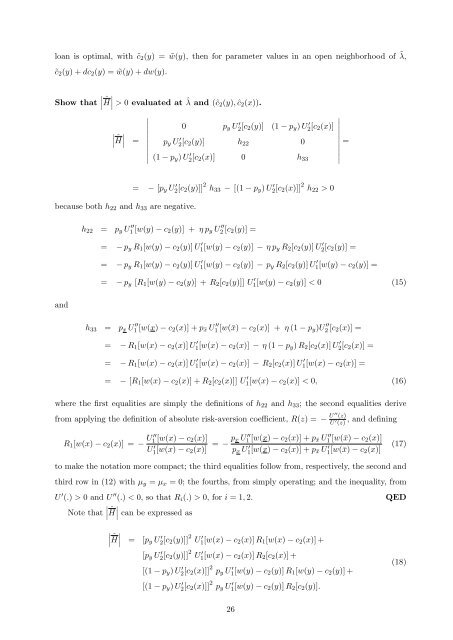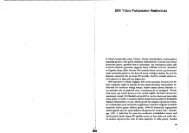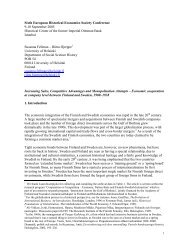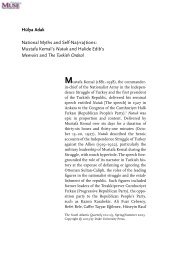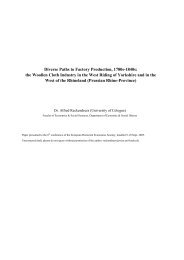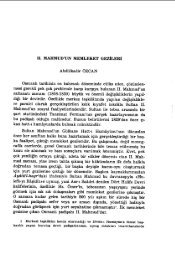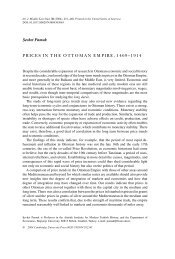The Birth of Insurance Contracts - The Ataturk Institute for Modern ...
The Birth of Insurance Contracts - The Ataturk Institute for Modern ...
The Birth of Insurance Contracts - The Ataturk Institute for Modern ...
Create successful ePaper yourself
Turn your PDF publications into a flip-book with our unique Google optimized e-Paper software.
loan is optimal, with ˜c2(y) = ˜w(y), then <strong>for</strong> parameter values in an open neighborhood <strong>of</strong> ˜ λ,<br />
˜c2(y) + dc2(y) = ˜w(y) + dw(y).<br />
<br />
<br />
Show that ˆ <br />
<br />
H<br />
> 0 evaluated at ˆ λ and (ĉ2(y), ĉ2(x)).<br />
<br />
<br />
ˆ <br />
<br />
<br />
0 py U<br />
<br />
H<br />
= <br />
<br />
<br />
<br />
<br />
′ 2 [c2(y)] (1 − py) U ′ 2 [c2(x)]<br />
py U ′ 2 [c2(y)] h22 0<br />
(1 − py) U ′ 2 [c2(x)]<br />
<br />
<br />
<br />
<br />
<br />
<br />
=<br />
<br />
<br />
0 h33 <br />
because both h22 and h33 are negative.<br />
and<br />
= − [py U ′ 2 [c2(y)]] 2 h33 − [(1 − py) U ′ 2 [c2(x)]] 2 h22 > 0<br />
h22 = py U ′′<br />
1 [w(y) − c2(y)] + η py U ′′<br />
2 [c2(y)] =<br />
= − py R1[w(y) − c2(y)] U ′ 1[w(y) − c2(y)] − η py R2[c2(y)] U ′ 2[c2(y)] =<br />
= − py R1[w(y) − c2(y)] U ′ 1[w(y) − c2(y)] − py R2[c2(y)] U ′ 1[w(y) − c2(y)] =<br />
= − py [R1[w(y) − c2(y)] + R2[c2(y)]] U ′ 1[w(y) − c2(y)] < 0 (15)<br />
h33 = px U ′′<br />
1 [w(x) − c2(x)] + p¯x U ′′<br />
1 [w(¯x) − c2(x)] + η (1 − py)U ′′<br />
2 [c2(x)] =<br />
= − R1[w(x) − c2(x)] U ′ 1[w(x) − c2(x)] − η (1 − py) R2[c2(x)] U ′ 2[c2(x)] =<br />
= − R1[w(x) − c2(x)] U ′ 1[w(x) − c2(x)] − R2[c2(x)] U ′ 1[w(x) − c2(x)] =<br />
= − [R1[w(x) − c2(x)] + R2[c2(x)]] U ′ 1[w(x) − c2(x)] < 0, (16)<br />
where the first equalities are simply the definitions <strong>of</strong> h22 and h33; the second equalities derive<br />
from applying the definition <strong>of</strong> absolute risk-aversion coefficient, R(z) = − U ′′ (z)<br />
U ′ (z) , and defining<br />
U ′′<br />
1 [w(x) − c2(x)]<br />
R1[w(x) − c2(x)] = −<br />
U ′ 1 [w(x) − c2(x)] = − px U ′′<br />
1 [w(x) − c2(x)] + p¯x U ′′<br />
1 [w(¯x) − c2(x)]<br />
px U ′ 1 [w(x) − c2(x)] + p¯x U ′ 1 [w(¯x) − c2(x)]<br />
to make the notation more compact; the third equalities follow from, respectively, the second and<br />
third row in (12) with µy = µx = 0; the fourths, from simply operating; and the inequality, from<br />
U ′ (.) > 0 and U ′′ (.) < 0, so that Ri(.) > 0, <strong>for</strong> i = 1, 2. QED<br />
<br />
<br />
Note that ˆ <br />
<br />
H<br />
can be expressed as<br />
<br />
<br />
ˆ <br />
<br />
H<br />
= [py U ′ 2 [c2(y)]] 2 U ′ 1 [w(x) − c2(x)] R1[w(x) − c2(x)] +<br />
[py U ′ 2 [c2(y)]] 2 U ′ 1 [w(x) − c2(x)] R2[c2(x)] +<br />
[(1 − py) U ′ 2 [c2(x)]] 2 py U ′ 1 [w(y) − c2(y)] R1[w(y) − c2(y)] +<br />
[(1 − py) U ′ 2 [c2(x)]] 2 py U ′ 1 [w(y) − c2(y)] R2[c2(y)].<br />
26<br />
(17)<br />
(18)


